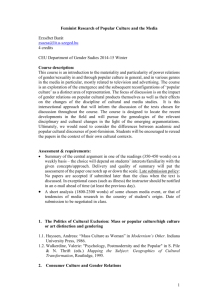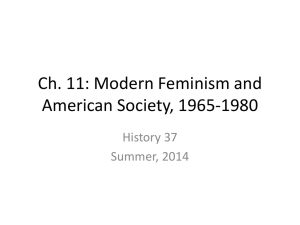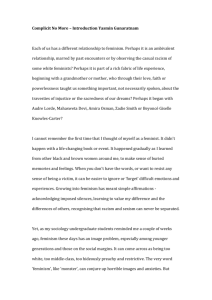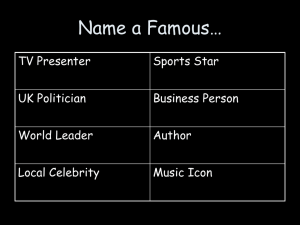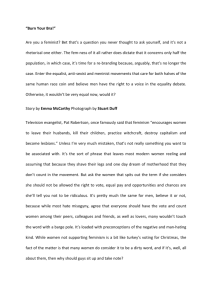paytoneng6702annotatedbibliographygetto
advertisement
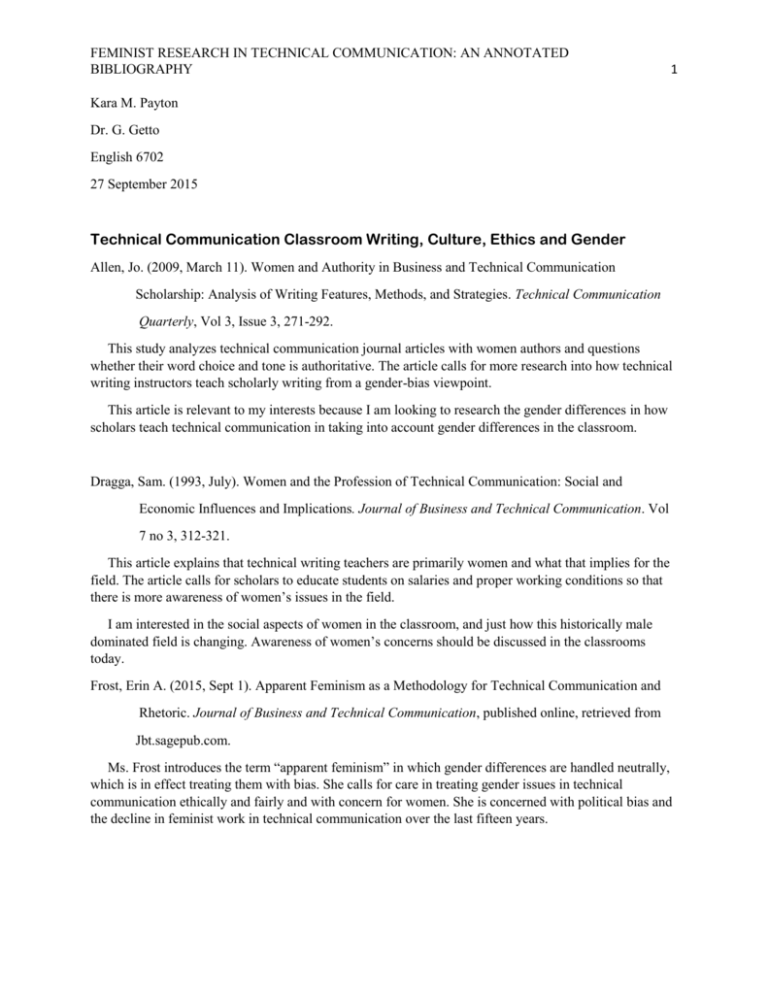
FEMINIST RESEARCH IN TECHNICAL COMMUNICATION: AN ANNOTATED BIBLIOGRAPHY 1 Kara M. Payton Dr. G. Getto English 6702 27 September 2015 Technical Communication Classroom Writing, Culture, Ethics and Gender Allen, Jo. (2009, March 11). Women and Authority in Business and Technical Communication Scholarship: Analysis of Writing Features, Methods, and Strategies. Technical Communication Quarterly, Vol 3, Issue 3, 271-292. This study analyzes technical communication journal articles with women authors and questions whether their word choice and tone is authoritative. The article calls for more research into how technical writing instructors teach scholarly writing from a gender-bias viewpoint. This article is relevant to my interests because I am looking to research the gender differences in how scholars teach technical communication in taking into account gender differences in the classroom. Dragga, Sam. (1993, July). Women and the Profession of Technical Communication: Social and Economic Influences and Implications. Journal of Business and Technical Communication. Vol 7 no 3, 312-321. This article explains that technical writing teachers are primarily women and what that implies for the field. The article calls for scholars to educate students on salaries and proper working conditions so that there is more awareness of women’s issues in the field. I am interested in the social aspects of women in the classroom, and just how this historically male dominated field is changing. Awareness of women’s concerns should be discussed in the classrooms today. Frost, Erin A. (2015, Sept 1). Apparent Feminism as a Methodology for Technical Communication and Rhetoric. Journal of Business and Technical Communication, published online, retrieved from Jbt.sagepub.com. Ms. Frost introduces the term “apparent feminism” in which gender differences are handled neutrally, which is in effect treating them with bias. She calls for care in treating gender issues in technical communication ethically and fairly and with concern for women. She is concerned with political bias and the decline in feminist work in technical communication over the last fifteen years. FEMINIST RESEARCH IN TECHNICAL COMMUNICATION: AN ANNOTATED BIBLIOGRAPHY 2 This fits into my interests because as Ms. Frost points out, there is a decline in the gender difference issues in technical communication research. Most of the articles I have read see gender neutrality in textbooks and classrooms as ignoring the social implications of gender difference in the classroom and beyond. She calls for more research in this area. Lay, Mary. (1993). “Gender Studies: Implications for the Professional Communication Classroom”. Blyer, Nancy, Rounds, Thralls, Charlotte (Eds.), Professional Communication: The Social Perpective.Sage. Newbury Park. 259-272. The book is a collection of fourteen essays on the social aspects of technical writing in the classroom. This article by Mary Lay is a Winner of a 1993 NCTE Award in Technical and Scientific Communication. This book is interesting to me because gender studies is an area where there is a “gap” in the research in technical communication. Mary Lay was one of the first to do groundbreaking research in this area of women and gender studies. Lay, Mary M. (1989, September). Interpersonal Conflict in Collaborative Writing: What We Can Learn From Gender Studies. Journal of Business and Technical Communication, Vol 3, No 2, 5-28. This is a study on how women and men collaborate on writing projects differently. Men and women have different communication behaviors. According to the study, men tend to be more aggressive verbally, problem-oriented and risk taking; women tend to self-disclose to gain trust, be more emotional and read other’s emotions better, more cooperative and less willing to assume leadership. She calls for both sexes to develop a spirit of cooperation in collaborative work. She calls for using journal writing to identify emotions and develop proper strategies for the group work in classrooms. I am interested in this study because of the different way women and men learn to work together in the classroom and beyond. However, further research showed that there really are not many differences once both assimilate into corporate or academic culture. I think that in the male-dominated classrooms, teachers or professors have a difficult time incorporating the talk of women’s issues that still exist. Thompson, Isabelle. (2004, July). Sex Differences in Technical Communication: A Perspective on Social Role Theory. Journal of Technical Writing and Communication. Vol 34, 217-232. The article calls for social change on women and technical communication. The article claims that sex differences are perpetuated through social roles in the family and the workplace. She evaluates the latest research in technical communication on sex differences and revisits the collaborative styles of men and women, reminiscent of Mary Lay’s original article on interpersonal conflict in collaborative writing. I am interested in this article because it is interesting to think the roles that family hierarchies and work hierarchies perpetuate gender difference stereotypes. FEMINIST RESEARCH IN TECHNICAL COMMUNICATION: AN ANNOTATED BIBLIOGRAPHY 3 Women and the History of Technical Communication Durack, Katherine. (1997, Summer). Gender, Technology, and the History of Technical Communication. Technical Communication Quarterly, Vol 6 no 3, 249-260. This article explains that scholarly articles that have largely left out women in the history of technical communication, as “women’s work” is considered in the home domain and not as important as the work world. The article points out that women’s technology differs from men’s, yet it is equally important in history. This article is of interest to me because we have to know history in order to have a good grasp of the future of technical communication. The article defined technology to include tools from the home, such as sewing machines or stoves. It explains how the Industrial Revolution separated the workplace from the home, relegating women to the domain of the home. Interestingly, it points out that a typical “workplace” is now going back to home, as more telecommuters and home-based businesses are the norm. Gender and Technology Hwang, Young Suk, Fisher, William, Vrongistinos, Konstntinos. (2009). Calibrating a Measure of Gender Differences in Motivation for Learning Technology. Journal of Instructional Psychology, 36 (3), This article is a study of middle school children and their feelings about technology. The study finds that cultural influences affect girls’ feelings about studying technology in the classroom. Boys are more motivated to learn technology. Girls’ lack of motivation was the key hindrance to girls learning technology; and therefore, going into science and technology as a profession. The article calls for more research on girls or women and technology, since much research has been done on girls and mathematics. This article was of interest to me because I would like to know more about women and how they learn technology in the classroom, and the cultural implications behind it. According to White et Al (2015), technical communicators are mostly men, yet many of the English professors are women. In the article, she states it is difficult to bring up women’s’ concerns in a male-dominated classroom. If more research was done in this area, educators may become aware of the cultural influences behind motivation to learn technology in the classroom Vanzo, Rohrer Valentina, Stern, Tobias, Ponocny-Seliger, Elizabeth, Schwarzbauer, Peter, (2015). Technical Communication in Assembly Instructions: An Empirical Study to Bridge the Gap Between Theoretical Gender Differences and Their Practical Influence. Journal of Business and Technical Communication, 1-30. FEMINIST RESEARCH IN TECHNICAL COMMUNICATION: AN ANNOTATED BIBLIOGRAPHY 4 This study examined gender differences in assembling a product, showing that technical writers should target their writing to women when appropriate. The study’s results show women are more negatively impacted by improper assembly instructions. The study is helpful to technical writers that want to target their audiences. I am interested in this study because it shows how gender differences really do impact technical writers who want to target to all audiences. Gender Differences and Brain Structure: How the Media Skews Scientific Writing about Research O’Connor, Cliodhna, Joffe, Helene. (2014). Gender on the Brain: A Case Study of Science Communication in the New Media Environment, retrieved online from ProQuest. A case study involving gender differences in the structure of the brain and how media shapes and perpetuates negative gender stereotypes. The article traced the study’s impact from original scientific study through media channels. O’Connor and Joffe (2014) question how scientific studies on sex differences get skewed in the media and the ethical implications for researchers. The study involved structural outcomes of the brains of 949 individuals aged between 8-22 years. Males showed greater within hemisphere-connectivity and females showed greater between-hemisphere connectivity in all regions except the cerebellum. The study sparked a debate and skewed results in the media. I think it is interesting how scientific writing on sex differences is skewed in the media. The article shows that the study perpetuated the myths of gender stereotypes and women being less intelligent than men. I think it brings up a good point for the technical communicators to ethically think of what biases or stereotypes that are in their own writings. Overview of Feminist Research in Technical Communication Thompson, Isabelle, Overman, Elizabeth. (2006). Women and Feminism in Technical Communication —An Update. Journal of Technical Writing and Communication, Vol 36(2), 183-199. She conducts a study on twenty-one journal articles containing the subject of feminism and gender differences in technical communication. The study identifies keywords like “gender” or “women” in their titles. She also tracks the themes in the studies from 1997 to 2002, and that feminist critics in technical communication went from radical non-equality cries to postmodern feminism that calls for critique outside of the field. In other words, technical communication researcher’s interest in gender and feminism has declined over the last fifteen years, and this article calls for more research. This study was interesting because gender differences in technical communication is becoming less of a topic of research, leaving a “gap” for further research articles. I wonder why the decline in interest in women and technical communication? I think it is a call for further research. FEMINIST RESEARCH IN TECHNICAL COMMUNICATION: AN ANNOTATED BIBLIOGRAPHY 5 Thompson, Isabelle. (1999). Women and Feminism in Technical Communication: A Qualitative Content Analysis of Journal Articles Published in 1989 through 1997. Journal of Business and Technical Communication. 13(2), 154-178. Retrieved from ProQuest Online. This article is a study on 40 articles about women and feminism published in five technical writing journals over a period of nine years. Study shows that women are gaining acceptance in the workplace, but it is unclear if the workplace changed or they changed their behaviors to become more masculine. Again, the study shows that the topics of research have become less radical and the research itself on feminism and technical writing has dwindled. I am interested in this study because it gives an overview of feminism and technical writing journal articles. It points out a research “gap” in scholarly research today on gender difference, feminism and technical communication. The study shows just what has been done in research in the field. White, Kate, Rumsey-Kesler Suzanne, Amidon, Stevens, (2015). Are We “There” Yet? The Treatment of Gender and Feminism in Technical, Business, and Workplace Writing Studies. Journal of Technical Writing and Communication. Retrieved from jtw.sagepub.com September 18, 2015. The study reviews research in feminism in technical communication. They conclude that gender issues are a minor concern in business and technical writing classrooms and that little has been done to challenge this state. The results show little has changed in the last twenty-five years. Also, the study analyzes nine popular textbooks for gender bias terms. In the study, 863 articles were reviewed and only twenty-two articles were on feminism. There was a significant decline in research on feminism and technical communication from Thompson’s study in 1999. Again, this article highlights the fact that business and technical writing is genderless and much of the gender issues are ignored in the classroom and perpetuated in the workplace. The study points to a research gap in feminism and technical communication.


